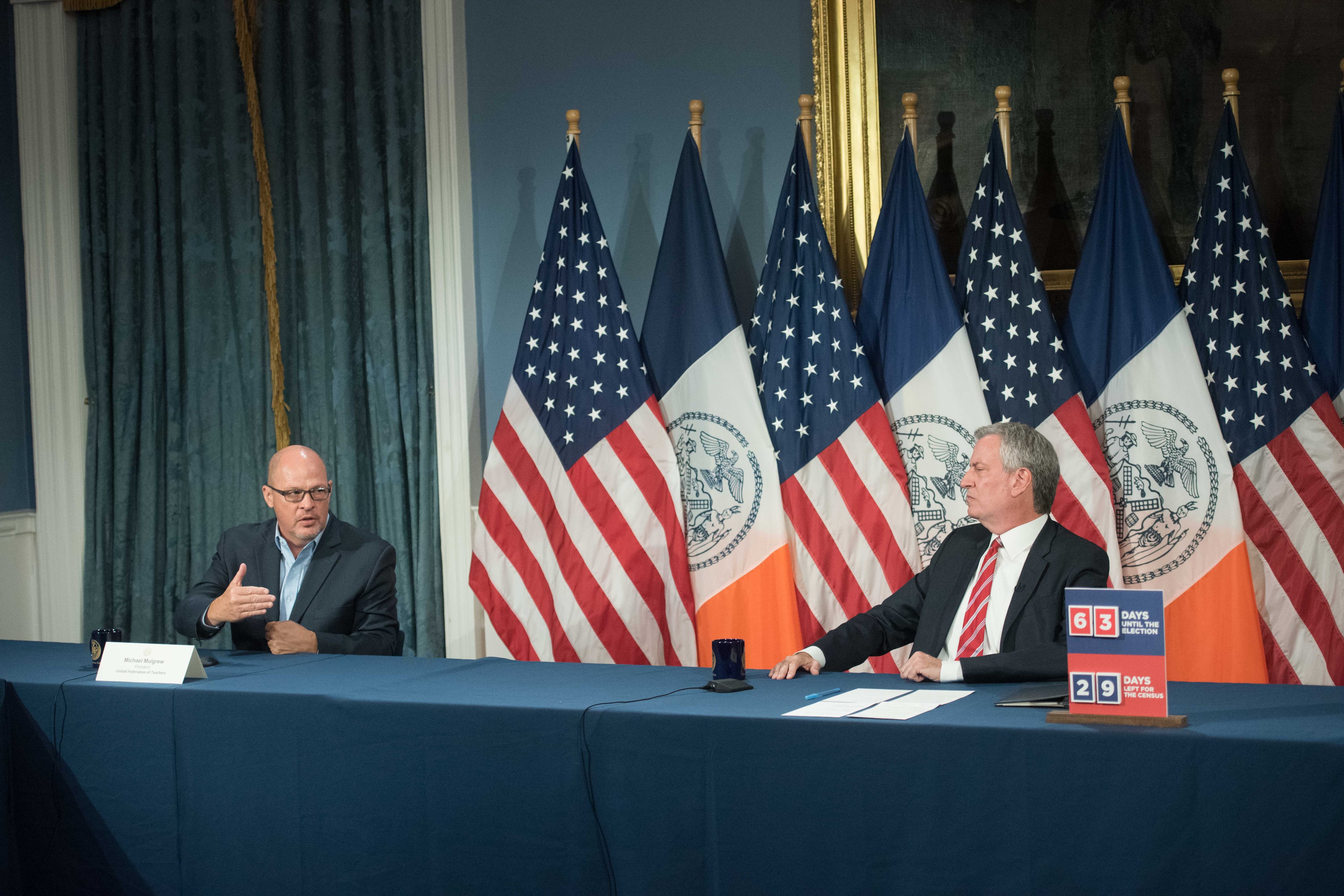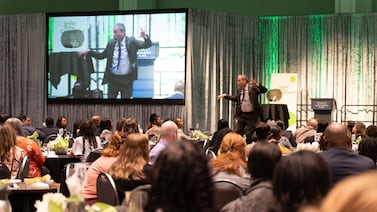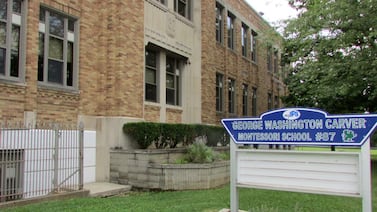The start of the school year in New York City will be delayed, Mayor Bill de Blasio announced Tuesday after hastily reaching a deal with union leaders who had warned it wasn’t safe to reopen buildings on Sept. 10 as originally planned.
All students will begin a “transition and orientation” period on Sept. 16. Regular coursework will not resume for students in-person or remotely until school buildings reopen on Sept. 21. Teachers are expected to report to buildings on Sept. 8, as previously scheduled.
New York City had been the lone holdout among the nation’s largest school systems for an on-time return to in-person learning. But in recent days, the mayor faced a threat of a teachers strike and demands for a delay from hundreds of principals across the five boroughs who said it was impossible to prepare to reopen the doors of the city’s some 1,800 schools while still facing the threat of the coronavirus. The teachers union had been considering a strike authorization vote during a meeting of its 3,200-member delegate assembly on Tuesday afternoon.
For months, de Blasio has held firm on reopening school buildings on time, arguing that fully virtual learning could be disastrous for the city’s students, about 73% of whom come from low-income families.
“Nothing — nothing replaces in-person learning,” de Blasio emphasized during a press conference on Tuesday. He said that the city’s new safety protocols represent “the highest standard anywhere in the world.”
Officials did not immediately say whether the delay will mean that students and teachers will make up additional days throughout the school year.
Pushing back the return date gives teachers and principals more time to prepare for an unprecedented school year, which will require educators to overhaul everything from how children stream into their school buildings to how to teach young learners to read through a computer screen. Without the delay, teachers and principals were slated to have just two days together before reopening buildings.
“We need to get the people in the room. So that’s what we’re doing with this agreement,” said Mark Cannizzaro, head of the principals union, who joined de Blasio along with other union leaders for the announcement. “We’re getting the people in the room to work out the logistics.”
The agreement between the city and labor leaders includes random, monthly testing of staff and students for COVID-19. Officials said 10 to 20% of a school’s population could be randomly tested based on its size. Sampling will happen “in or near” school and will be self-administered — not the more invasive swabs which reach far back into the nasal cavity, de Blasio said. Parents of students learning in-person will be asked for consent to random testing.
Still, the deal does not include mandatory testing of students and staff before school buildings reopen, something union officials had been demanding. Instead, the city is prioritizing students and teachers at 34 testing sites across the city with results in under 48 hours.
Once random testing begins on Oct. 1, any student who declines to be tested will be switched to fully-virtual instruction, union officials said, and staff members who refuse will be placed on unpaid leave. Some of the details of the new testing system were still being finalized, a union spokesperson said.
Testing had been one of the major sticking points for the United Federation of Teachers, whose leaders had called for wide-scale antibody surveys to be required of both staff and students. The mayor had remained publicly opposed to mandated testing up until the morning before the new agreement was announced, and instead the city only encouraged teachers to get tested for the virus.
The agreement was struck between the UFT, the Council of School Administrators and Supervisors, which represents principals, and District Council 37, which represents school cafeteria workers, contact tracers, and nurses.
The mayor had been insistent on reopening buildings partly to relieve parents of child care and help families get back to work. But it wasn’t immediately clear what the agreement to delay means for the city’s Regional Enrichment Centers, or RECs, which have been providing child care to essential workers since the spring.
Most are in school buildings, and some had already begun to close down in preparation for the school year. In their place, the city had planned to open up child care centers run by community organizations, timed to open with the start of the school year and enroll students on the days they are not in school buildings. City leaders did not address whether those are still on track to begin serving children next week.
Whether the delay — which spans six school days — gives teachers and principals enough time to feel prepared to welcome back students remains to be seen. Schools are up against immense challenges.
On top of safety concerns, like whether classroom ventilation was up to par or whether schools received orders of personal protective equipment, school leaders worried they could not work out the logistics of delivering instruction. They are also grappling with ballooning staffing needs to teach students in both fully remote classes and in hybrid classes, where they’ll be learning in class for one to three days a week and virtually the rest of the time.
Many principals have been working all summer to meet the demands of various new requirements for social distancing and other health-related measures, often without concrete guidance from the city, they said. As the city continued to trickle out new guidance in recent days — including over 100 pages worth of instructions to principals sent just days ago — many school leaders grew increasingly exasperated by the impossibility of opening on Sept. 10, as they balanced the fears of teachers afraid to return to the classroom and concerns from parents unable to plan without certainty of knowing what their children’s school year would look like.
Roughly 37% of students have so far opted out of returning to school buildings, and families are allowed to opt out of in-person classes any time, making it difficult for principals to plan. City officials have declined to say how many teachers have so far received health accommodations to work remotely, but previously estimated that up to 20% might do so. Teachers can apply for accommodations any time of year as well, adding to staffing challenges.
Regardless of whether students are learning remotely full time or by a mix of in-person and remote, the majority of student instruction will still be remote. There are still significant questions about whether the department has taken adequate steps to improve remote instruction since school buildings shut down in March, a task that is falling to individual schools without clear guidance from the department.
Families who struggled with online learning worry that remote instruction will not be much better than it was in the spring. Then, schools were operating in emergency mode as the pandemic shut down the economy, eventually infecting more than 230,000 people in New York City and killing at least 19,000 — with another 4,650 suspected deaths attributed to the virus, health department data shows.
Michael Mulgrew, president of the UFT, said that pushing back the start of school buys teachers more time to build their skills after the trial-by-fire that took place this spring. However, there were few details about the training opportunities and other supports that will be given to educators.
“We know we can do it better because we’ve learned more,” he said. “We will have a stronger instructional program because of what we’re about to do over the next two weeks.”
Delaying the start of school is not unprecedented. New York City schools opened 11 days late in 1993 as officials cleared asbestos out of classrooms across the boroughs.
Even though school buildings are expected to open on Sept. 21, they could shut down if coronavirus infection rates surge above 3%, based on a seven-day rolling average, the mayor has said. The rates are currently about 1.3% citywide. Individual classrooms or whole school buildings could also shut down if students or staff test positive for the coronavirus.







